The palace's throne room was used for meetings between the monarch and the Naboo Royal Advisory Council. The throne, which stood in front of a large window in the room, also hid two blaster pistols in a compartment, which was added in 32 BBY by Eirtaé at the suggestion of Quarsh Panaka. The palace also had a hangar where several starships were stored in case of emergencies.
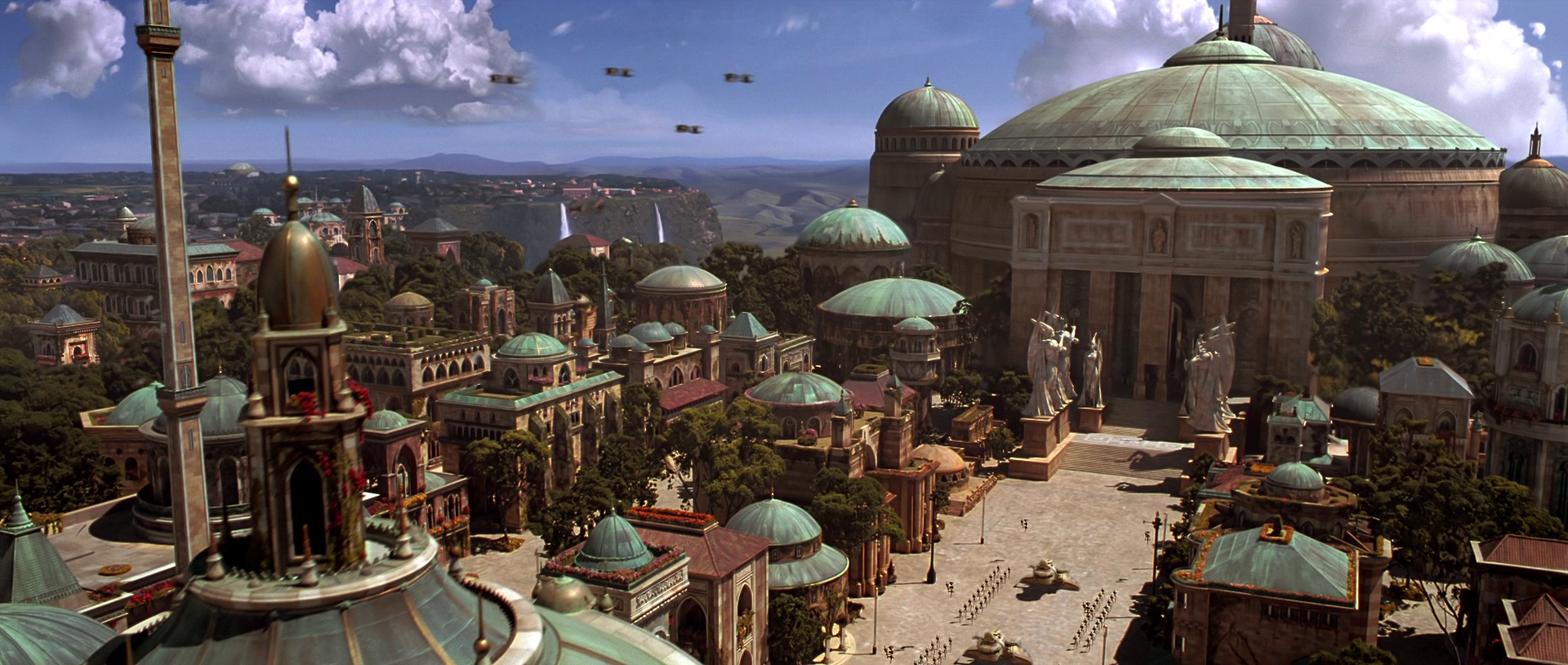
The Palace Plaza terminated at the entrance to the Royal Palace.
Considered the loveliest building in Theed, and thus the "Jewel of Naboo," the sprawling and baroque Theed Royal Palace was located in the city of Theed, capital of the Mid Rim planet Naboo's human inhabitants, atop a plateau split by the Solleu River and the river's own Virdugo Plunge and between Palace Plaza and the Cliffs of Theed. Both ornate and ancient, its architectural style resembled that of the city around it, containing dozens of linked sandstone towers topped with bright green domes trimmed with brass. One such tower, located near the back of the palace next to a skywalk, contained a library collection established by King Ars Veruna during his reign.
The palace grew over time, as it was traditional for each new monarch of Naboo to construct a new tower or turret for the palace, an act for which they would then seek public acclaim. Over time, the streets and buildings of Theed were constructed to radiate outward with the palace as their center, further emphasizing its importance. The main entrance to the palace lay beyond four statues and a staircase, and was often the ending point for any of the city's grand parades. A watchtower stood to the side of the building. A short ways away, the royal boathouse was located at the base of the cliffs.
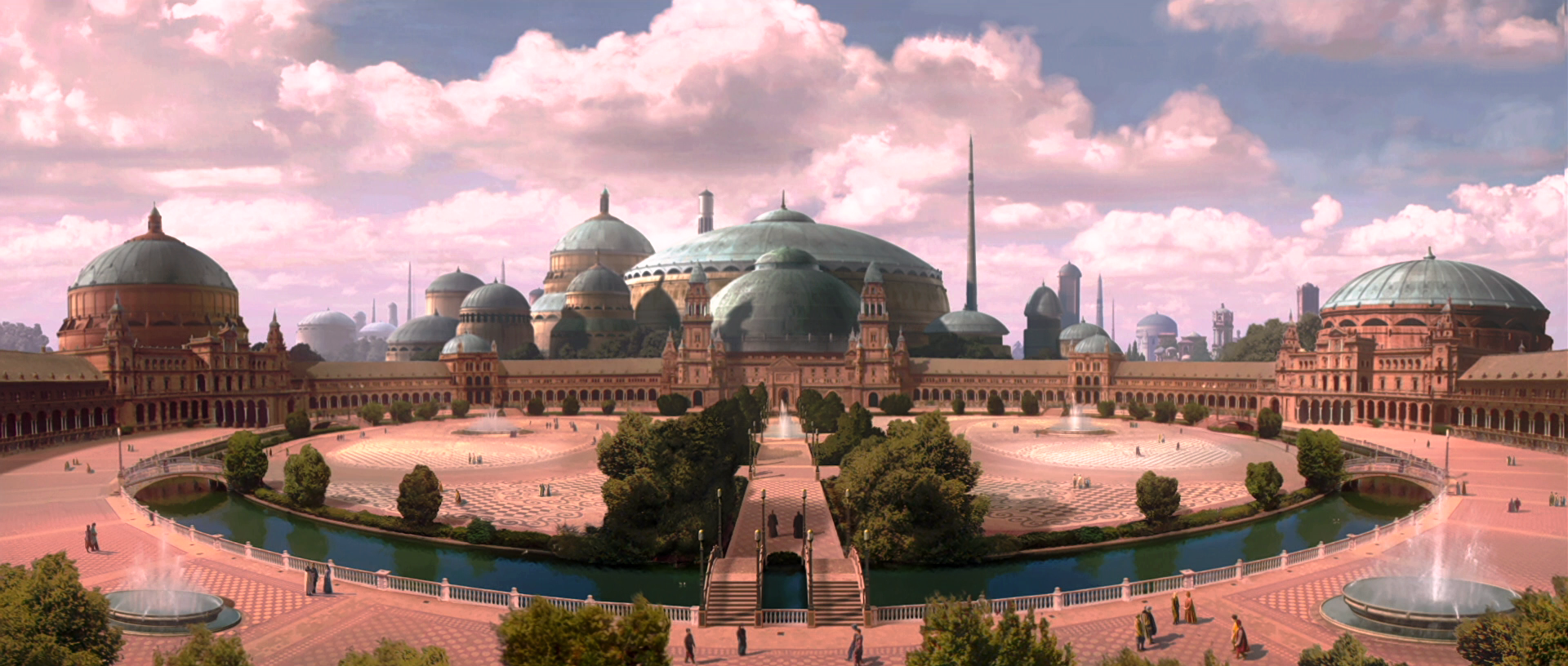
The Palace Courtyard, built from the ashes of the Trade Federation's invasion
A large and stately edifice, the Royal Palace dominated Theed and the surrounding area. The palace's importance was emphasized by the streets and buildings of Theed, which radiated from the structure. Nearby buildings were kept low-lying, and the main building was surrounded by parks and public spaces, allowing the structure to remain the focus of the city's skyline. The primary approach to the palace's entrance was the Palace Plaza, which terminated at a wide flight of steps leading to the principle portico of the Royal Palace itself. The plaza, stairs and portico served as the location for new monarchs' inauguration ceremonies and other major public events. The stairs were flanked by imposing statues of Naboo's foremost philosophers, artists, and historical leaders. Following the Invasion of Naboo by the Trade Federation, a section of Theed adjacent to the palace that had been severely damaged during the invasion was replaced by the Palace Courtyard, an enclosure that was designed to foster the principles of enlightenment.
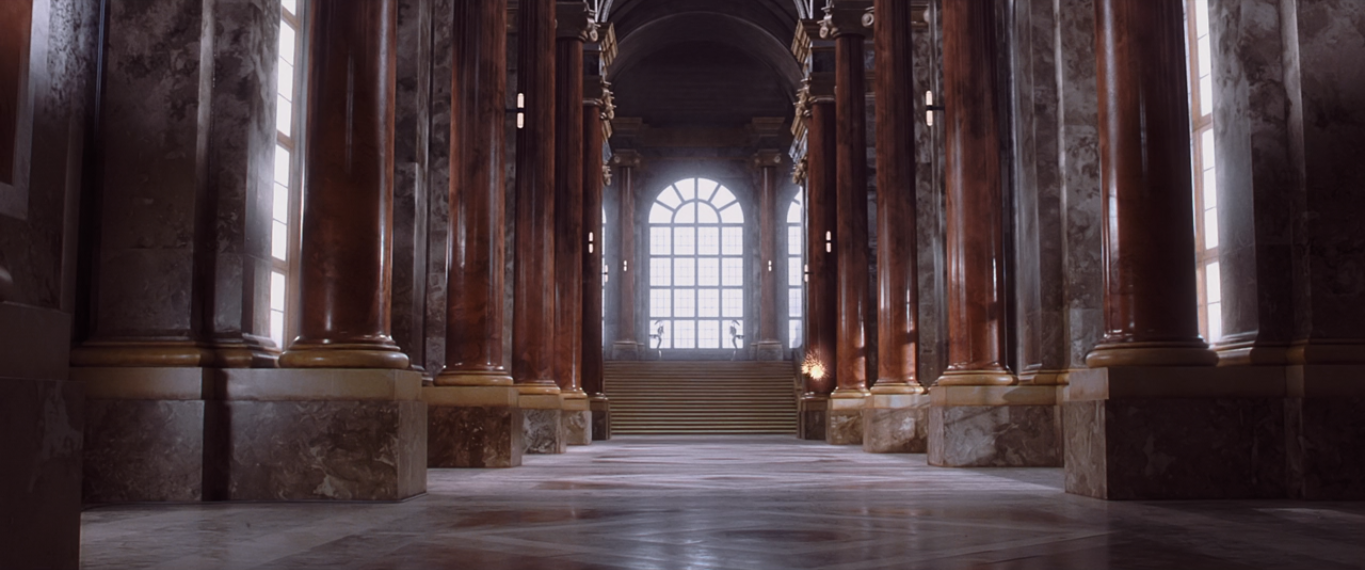
The halls of the palace were lined with towering columns.
The building's interior spaces were bright and airy, with tall, arched ceilings and many windows, giving even the smallest spaces a sense of openness. Several hallways were lined on each side with towering columns.
The central interior space was the throne room and a meeting hall that was used for meetings between the monarch and the Naboo Royal Advisory Council. A southwest hall, simply decorated except for large windows that took in a sweeping view of the city and its surroundings, was used for more informal gatherings. Other rooms included offices and quarters for the Naboo Palace Guard, which was tasked with protecting the monarch.
Naboo's queens used a suite on the fifth floor of the palace consisting of a dressing room with an extensive wardrobe system attached, a sitting room, a small meeting room and three rooms for sleeping with one intended for the queen to use. The queen also had a private library down the hall from the royal apartments that was reserved for her use. The Turret Room was located in a square tower near the back of the palace. Many rooms opened onto outdoor terraces and balconies. Within the palace were many disused chambers, secret rooms, and forgotten corridors.
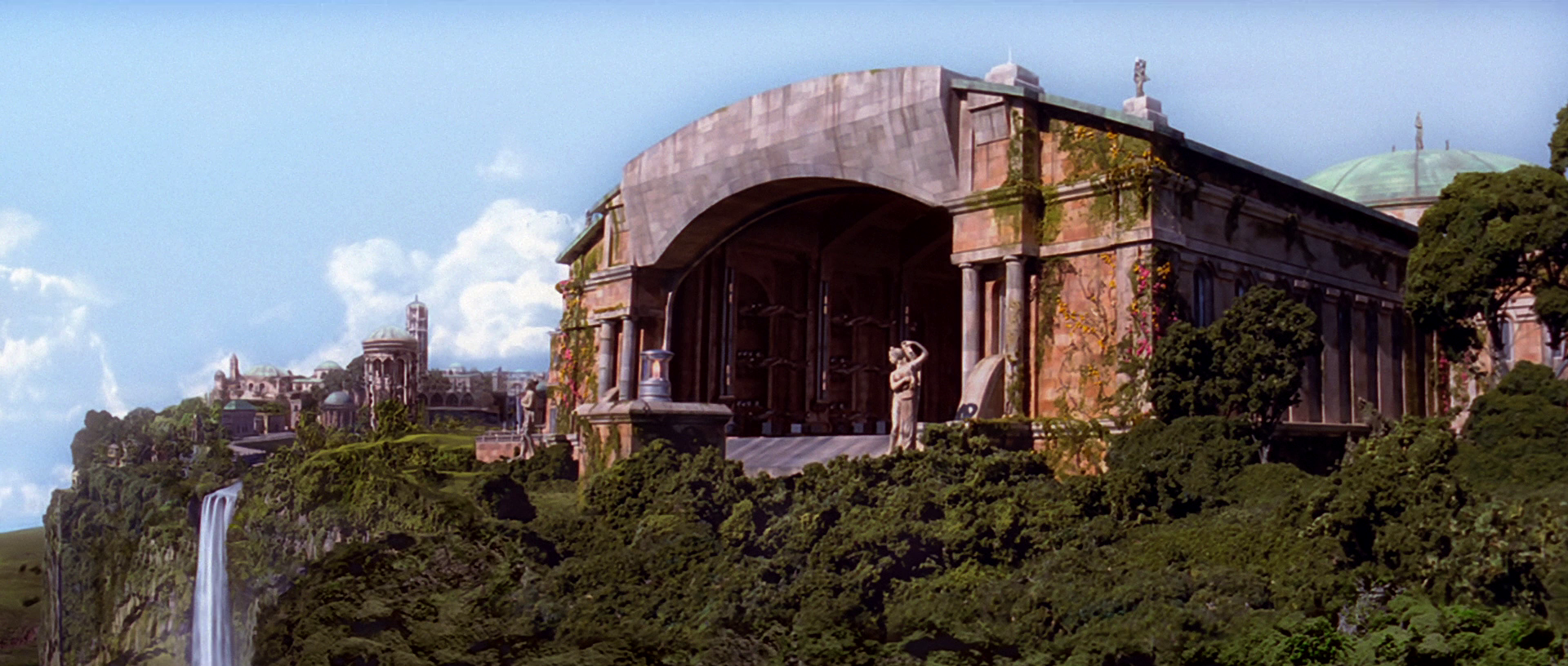
The Royal Starport was relocated next to the Theed power generator, becoming the Theed Hangar.
Up until the development of the N-1 starfighter, the caverns beneath the palace housed the Royal Starport, used as a private facility by Naboo's rulers and volunteer security forces. With the N-1 requiring an uninterrupted power supply, the Royal Starport was relocated adjacent to the Theed power generator and became the Theed Hangar, which was connected to the palace via a secret tunnel. The old starport then served as barracks for the palace guard and on-duty pilots.
During the Great Time of Peace in 832 BBY, the Theed Royal Palace was constructed by the people of Theed alongside the Solleu River on the Cliffs of Theed under the direction of King Jafan, who recently unified the Naboo and ended the Time of Suffering. The palace eventually became the residence of King Ars Veruna, who ruled Naboo for thirteen years and oversaw the construction of Veruna's tower, which housed a large royal library established by Veruna. In 382 BBY, during the High Republic Era, Jedi Knight Gella Nattai recognized an image of the palace on a screen that scrolled through galactic locations in a library on Supreme Chancellor Orlen Mollo's Longbeam cruiser Paxion.
Later throughout the Republic Era, the palace continued to serve as home to Naboo's monarchs, many of whom added on towers to the structure. One such addition was the constructed near the back of the palace, which was used to celebrate the Naboo holiday Festival of Light as a prominent fixture in the world's holiday schedule.
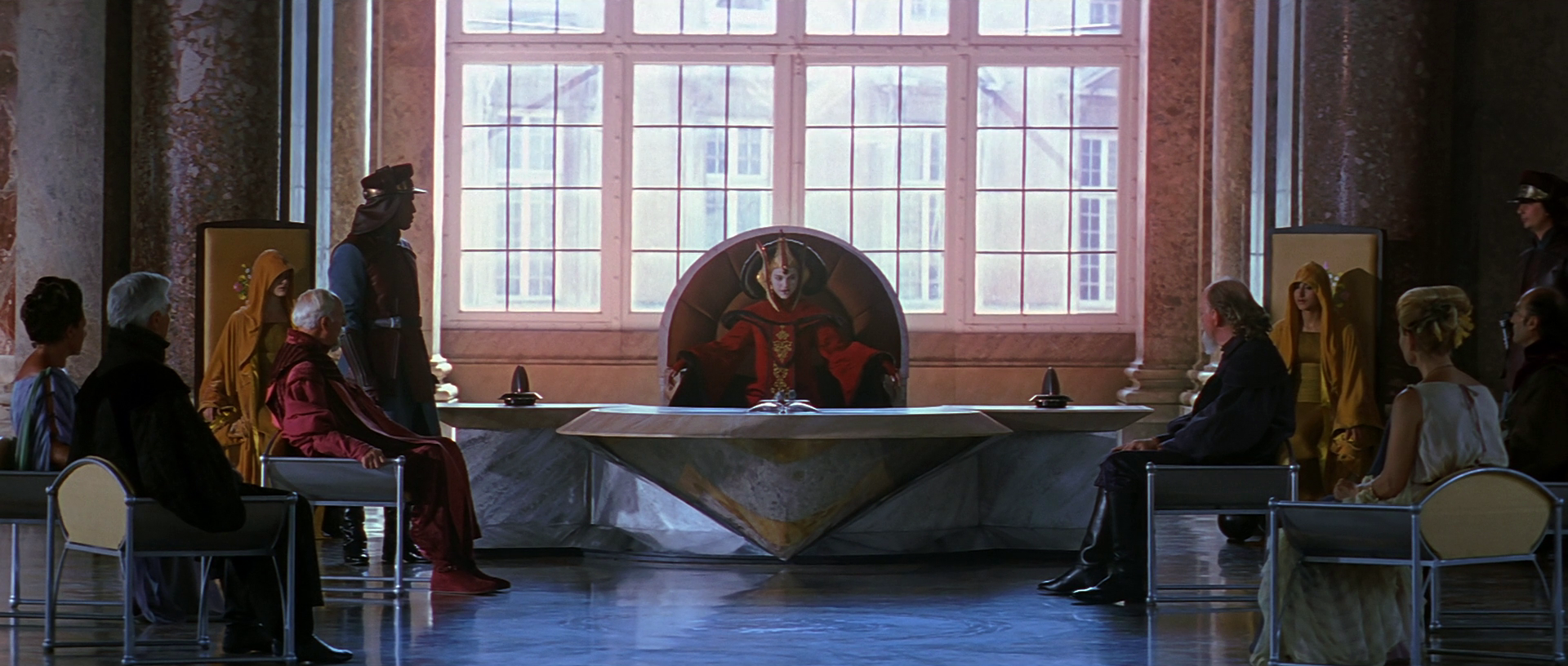
Queen Amidala, with her advisory council, in the throne room, at the Theed Palace.
In 32 BBY, shortly after Padmé Amidala's ascension as Queen of Naboo she told her head of security Quarsh Panaka that the only bodyguards she would have in her room were her handmaidens. To make up for this, Panaka added security measures into the room such as a weapons cache in the window seat which included a variety of things to help the Queen and several sensors that could detect a perimeter breach, several more for various types of weapons discharge and one that would detect the presence of blood, though Panaka's wife, Mariek Panaka, demanded that he remove the blood sensor following an incident with Saché, the queen's youngest handmaiden.
Early into her reign, Amidala hosted a summit at the palace with leaders of the other planets in the Chommell sector to improve relations, following the isolationist policies of Amidala's predecessor, Queen Sanandrassa. In the lead-up to the summit, Panaka put several measures of extra security in place, including a compartment in the centuries-old throne that could hide two blaster pistols. This was done by the engineer Eirtaé, one of Amidala's handmaidens, who made it so only the queen could open the compartment.
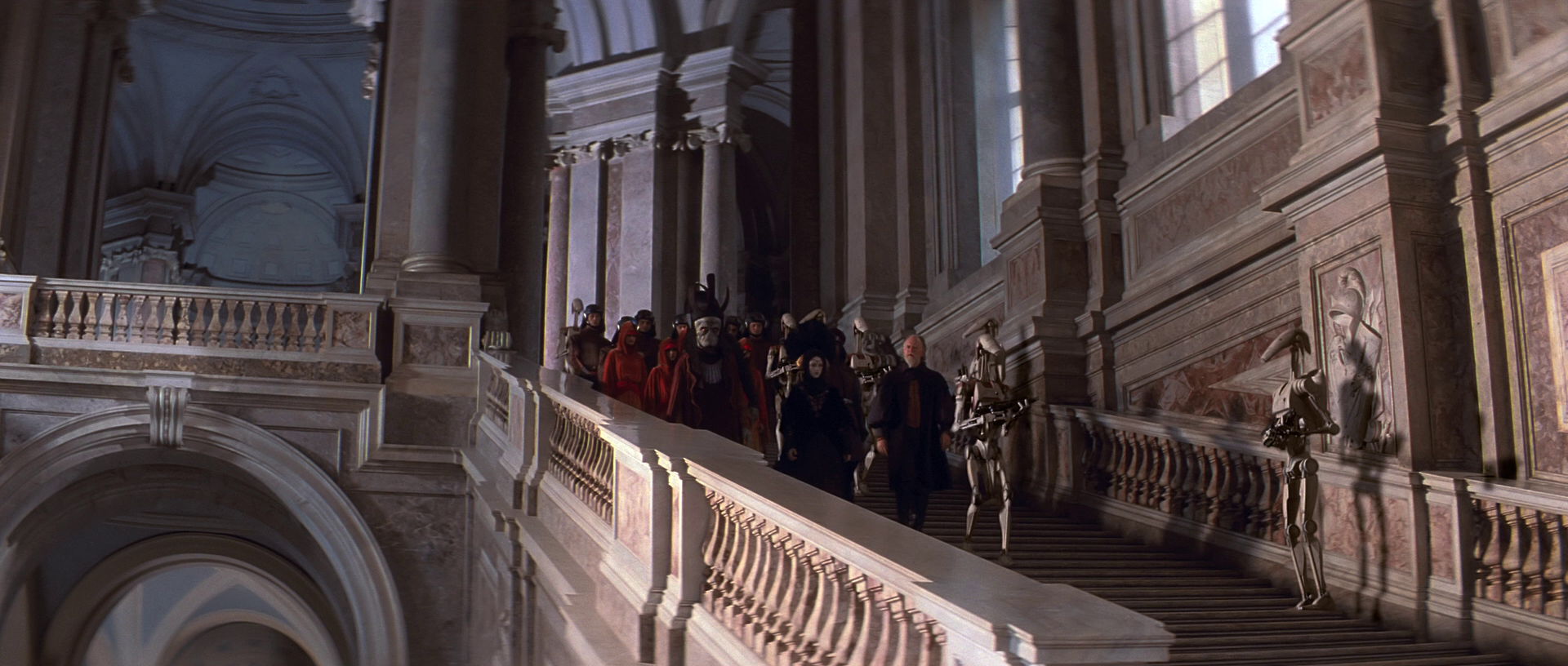
B1 battle droids surround Amidala and her retinue as the Trade Federation takes over the Palace.
During the Trade Federation's occupation of the planet, the palace was seized and used as their base of operations, with Viceroy Nute Gunray and his senior staff holding it as their residence until forces led by Queen Amidala assaulted it and captured Gunray. Later, Jedi Padawan Obi-Wan Kenobi, who had thought in the Battle of Naboo, was knighted by Yoda in the Turret Room inside the palace. There were also celebrations for the defeat of the Trade Federation on the palace stairs, where Amidala wore the Jubilation dress as she held the Globe of Peace.
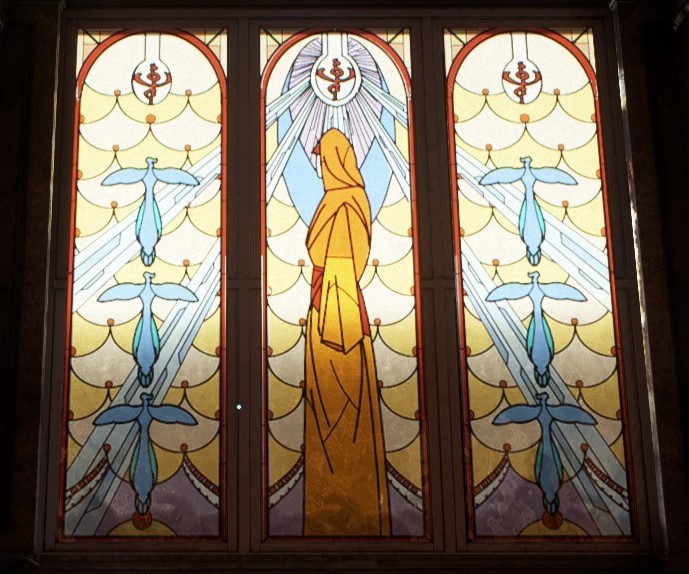
One of the stain glass windows, depicting Amidala's handmaidens, wearing their flame-colored robes.
After the invasion, the wing leading to the Theed Hangar was sealed, and, controversially, an ion pulse was installed in the palace as a precaution against further invasions. The system, powered by relays located throughout the city, disabled any electronic devices, including vehicles and weapons within its reach except those inside the palace. There were also several paintings and stained glass windows of Amidala's handmaidens wearing their flame-colored robes which were commissioned for the palace shortly after the invasion's end, including one with the handmaidens carrying a canopy over the queen. The droid R2-D2 kept a copy of the artwork in his memory and showed it to Amidala on at least one occasion, and the recognized the piece as from the Theed palace.
After Padmé's term as queen ended, the palace became the residence of her successor queen, Réillata, who had also served a term as queen before Amidala's reign. Following her second coronation, Réillata entered the throne room with Amidala and the others where she asked Amidala to succeed Senator Oshadam as the Chommell sector's representative in the Galactic Senate. Amidala then retired to one of the palace rooms with her entourage where she decided to accept Réillata's. Amidala returned to the palace again, after her first full session in the senate, to talk with Réillata about her progress. Réillata also oversaw the final construction of the coin pulse.
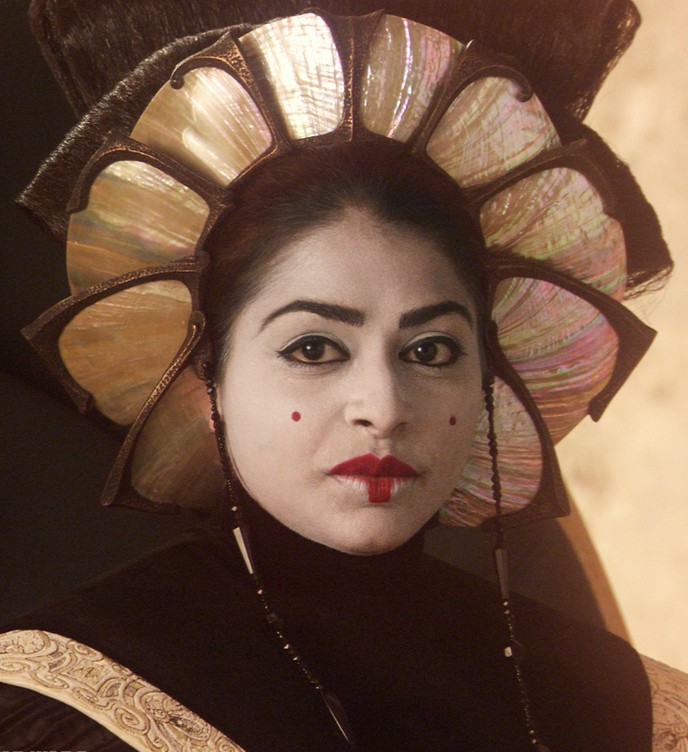
The palace eventually became the residence of Queen Jamillia.
The palace would eventually become the residence of Queen Jamillia. In 22 BBY, Amidala would once again return to the palace to speak with Jamillia and the Advisory Council regarding the Separatist Crisis and the looming threat of war. The same year, shortly after the First Battle of Geonosis, Jamillia prepared to transition out of office, which would result in her not living at the palace. The handmaiden Dormé sent recommendation letters to the palace for several candidates she had interviewed to be one of Amidala's handmaidens, thinking the individuals would be better suited to life in the Theed court. Around this time, the handmaiden Sabé thought fondly of her time living in the palace as one of Amidala's handmaidens years prior, including when they had snuck out to see a Neurotransmitter Affection concert.
Not long after, Jamillia had been replaced by the noticeably younger Queen Neeyutnee who ruled during the Clone Wars and moved fighter operations out of the palace. At Neeyutnee's request, Padmé returned once more when the presence of battle droids was discovered on Naboo and later for the Festival of Light, an event which celebrated Naboo joining the Galactic Republic. The festival took place in the Overlook stage of the palace courtyard under a ray shield and was the scene of an attempt to kidnap Supreme Chancellor Sheev Palpatine. Another attempt was made by Count Dooku in the palace , but he retreated in failure after a duel with Jedi Knight Anakin Skywalker. Amidala occasionally thought of her time as queen in the palace, mentally picturing herself with her handmaidens there shortly prior to a to Clabron.
Upon the formation of the Galactic Empire in 19 BBY, the queen at the time was Apailana, who was eventually replaced by Queen Dalné. However, the position of Monarch of Naboo was almost entirely ceremonial, with the true power lying in the hands of Moff Quarsh Panaka. However, Panaka spent most of his time in his chalet on Onoam, leaving Dalné in the palace. In 3 BBY, Dalné looked out her palace's windows and contemplated the world's moon, Onoam. She decided to depart the palace and travel to the moon, having little else to occupy her time by that point. Organa apologized to Dalné upon arrival, having assumed the queen would have remained in the Theed palace.
In 3 ABY, Sith Lord Darth Vader, who had once been Anakin Skywalker, flew past the Royal Palace in an Imperial shuttle to visit the Tomb of Padmé Amidala, which the palace overlooked and could be seen from.
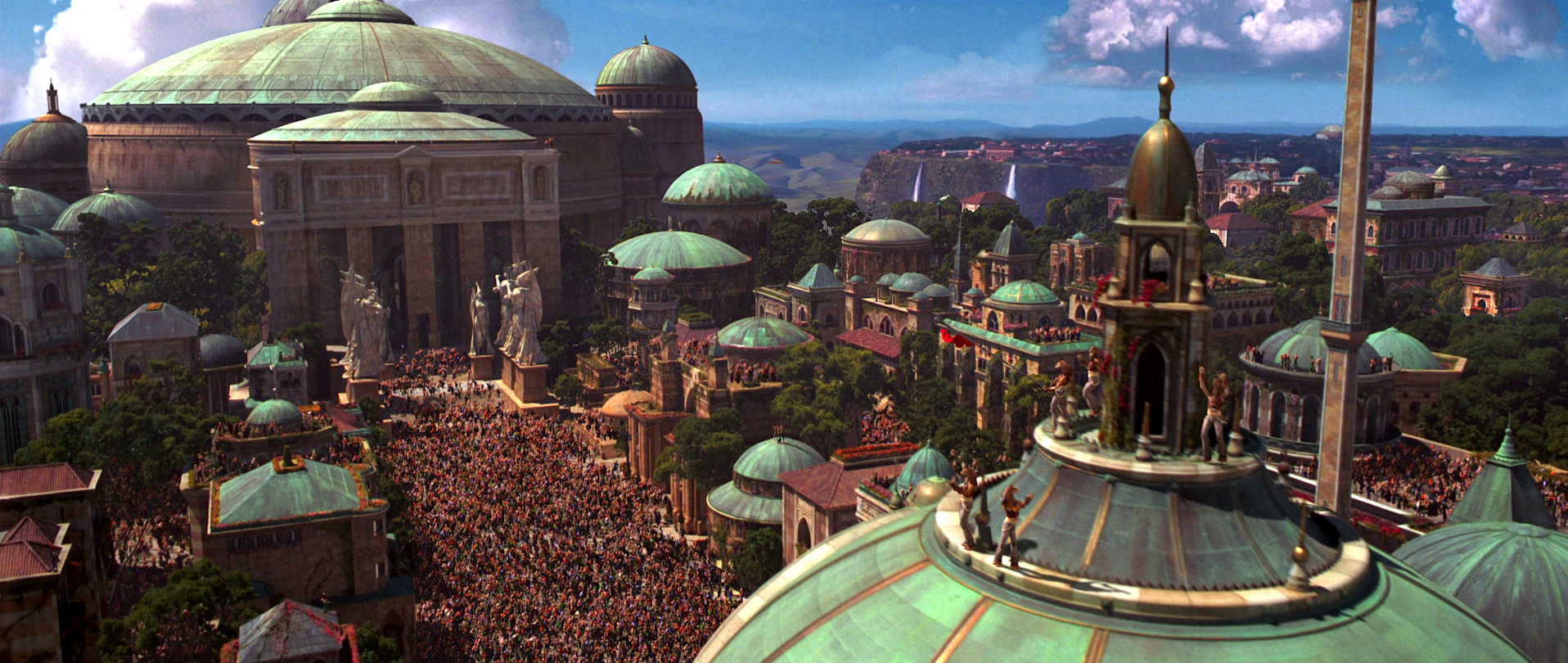
Naboo celebrates the fall of the Empire.
After the Battle of Endor which marked the fall of the Empire, celebrations took place in the plaza in front of the palace. By this point, Naboo was ruled by Queen Sosha Soruna, who stayed at the palace with her entourage including her head of security Captain Korro and her handmaidens.
Twenty days after the Battle of Endor, Soruna greeted Leia Organa and her pilot, Shara Bey, in the throne room where she offered her support to the New Republic that the rebellion was beginning to found. They were interrupted however when the Empire cut off their communications and Soruna had to open up the Theed Hanger, for the first time in over twenty years, using the Queen's Authority Override.
During the Battle of Theed against the Empire on Naboo, which was targeted by Emperor Palpatine, who hailed from Naboo, as part of Operation: Cinder, Rebel forces managed to activate the ion pulse and hold the palace. With the Imperials' weapons disabled and those of the rebels still functioning, the day was won by the Alliance. A picture of the palace was included in the Naboo section of the book Galactic Explorer's Guide, authored by the pirate Hondo Ohnaka and his protocol droid DK-RA-43 at some point after the Battle of Crait in 34 ABY.
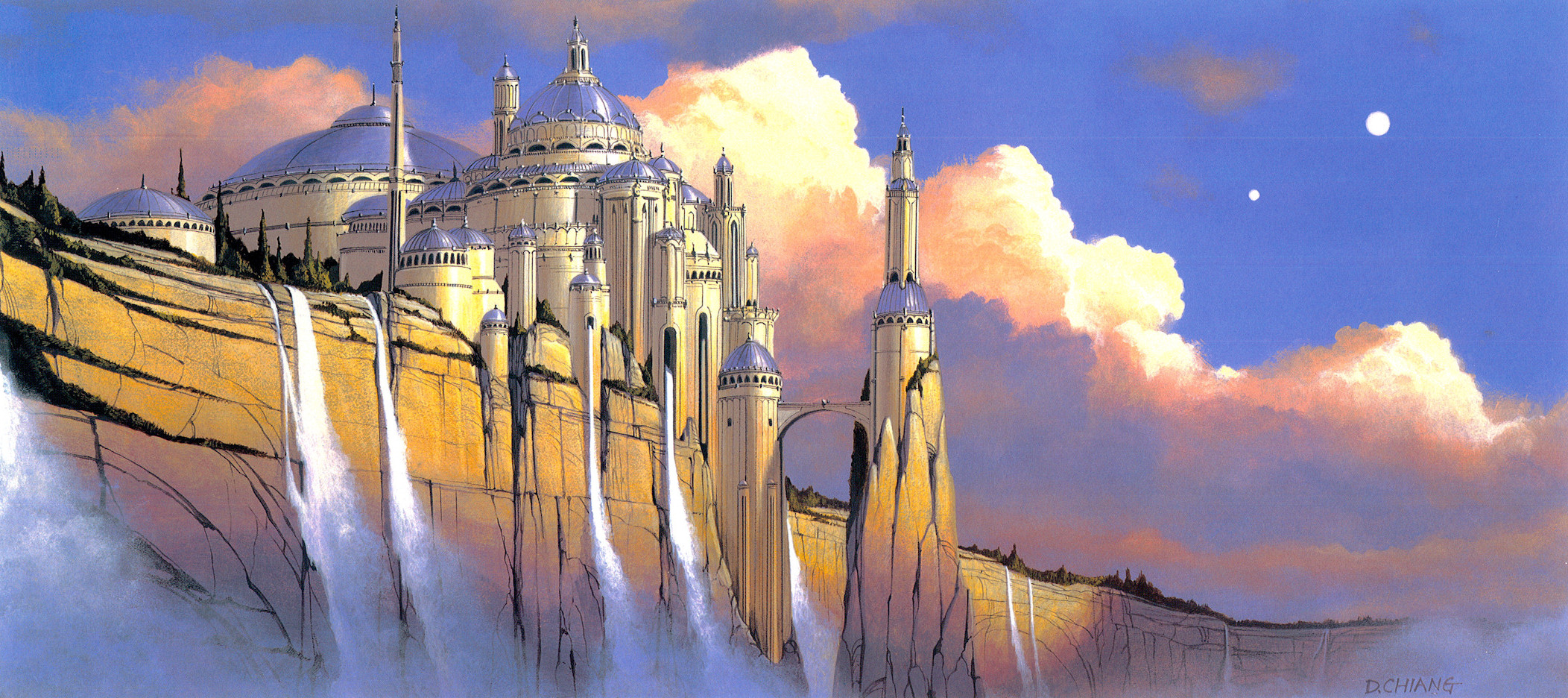
Concept art of the Theed Royal Palace by Doug Chiang
The Theed Royal Palace first appeared in the 1999 prequel trilogy film Star Wars: Episode I The Phantom Menace. For the film, artists Doug Chiang, Edwin Natividad, and Jay Shuster worked on production painting and storyboards for the palace, while created a matte painting of the palace and plaza. The final conceptual design of the palace facade was done by Kurt Kaufman, and a foam core conceptual model of Theed, including the palace, was created by . Concept art of the giant statues flanking the entrance of the palace was done by Natividad and was intended to make the figures appear made from marble and approximately 100 feet tall.
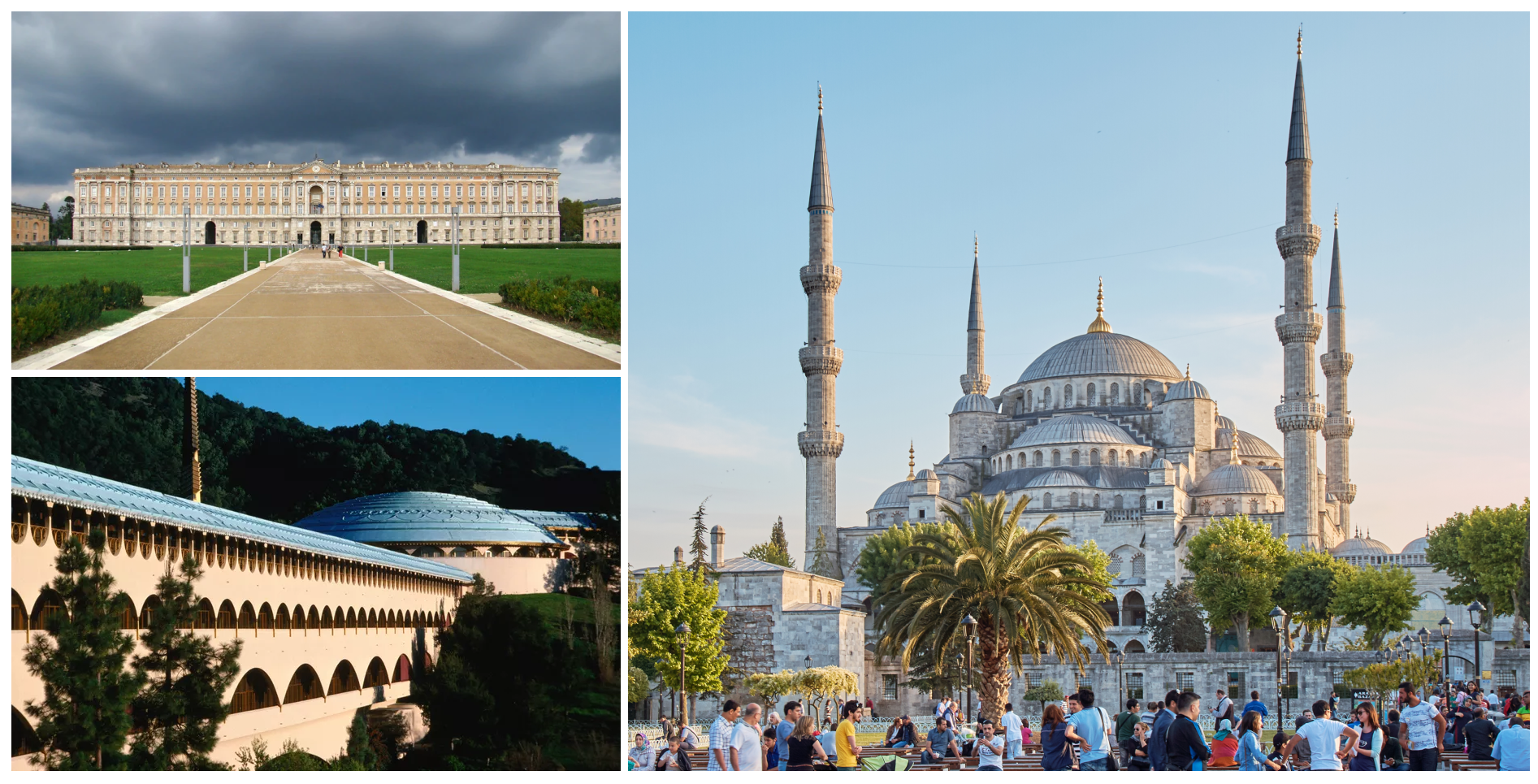
The Palazzo Reale (top left) was used as the palace interior, and the Marin County Civic Center (bottom left) and Blue Mosque (right) served as inspiration for the palace's exterior.
The Italian Renaissance-inspired design of Theed gradually evolved into a city paradise under the direction of George Lucas, filled with flourishing gardens and flowing rivers. The desired blend of real-world aesthetics emerged after months of studying Moorish, Italian, Moroccan, and Turkish architecture. Working alongside producer Rick McCallum, production designer Gavin Bocquet was tasked with searching for a building that could serve as the inspiration for the city's palace. In 1997, the Palazzo Reale of Caserta, Italy, became the interior of the film's palace. The baroque-rococo structure, built in 1752 to emulate Versailles, fit in seemlessly with the design work of the art department for the film, its interior matching Theed's strength and splendor, along with its light sense of beauty and amiability. For the palace's throne room, Natividad experimented with various shapes and materials, such as wood, marble, and metal, to find a configuration that best matched the Palazzo Reale, eventually settling on a sophisticated yet aggressive conical shape for the table. The throne itself was designed to be low and wide, allowing for backlighting, and were designed to emphasize Amidala's costume's unique silhouette, and all of the furniture pieces in the throne room were set dressing for the film.
For the exterior of the palace, the design had to enhance the natural landscape surrounding it, rather than mar it, so as to symbolize Naboo philosophy. Part of the solution was found in the dome-covered, aquaduct-like complex of the Marin County Civic Center in the hills above California's portion of U.S. Route 101. Further inspiration was drawn from the Blue Mosque in Istanbul, Turkey, for its multi-sized domes and six minarets along with its sense of symmetry; these inspirations were mixed with Venetian architecture to create the overall look of the palace exterior.
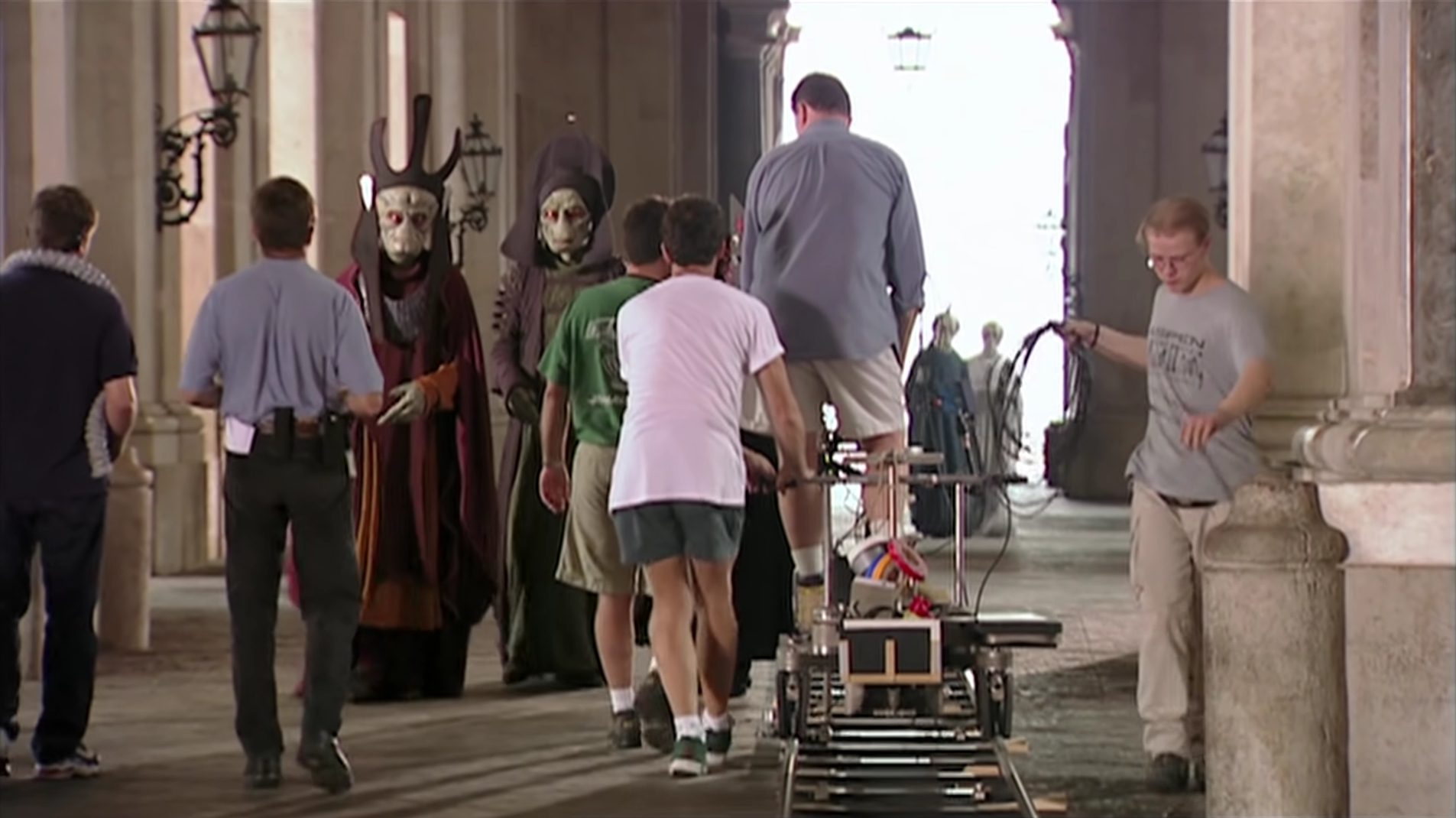
Filming of the scene with Sidious, Gunray, and Haako in the Palazzo Reale
The scene featuring Amidala being escorted by Gunray and Haako down the Royal Staircase was filmed on the Palazzo Reale's Honour Grand Staircase. Editing and camera work was used to hide the lion statues at the bottom of the stairs. At the top of the staircase is the passageway where the conversation between Gunray, Haako, and the hologram of Darth Sidious was filmed, and behind the camera during that shot is the location of the throne room. Lucas was unsatisfied with the light fixtures in one of the hallways in the palace, so they were replaced for the final version of the film. The archways of the palace leading outside were filled digitally with tanks and battle droids or with a matte painting.
- Disney Infinity 3.0
- LEGO Star Wars: The Skywalker Saga